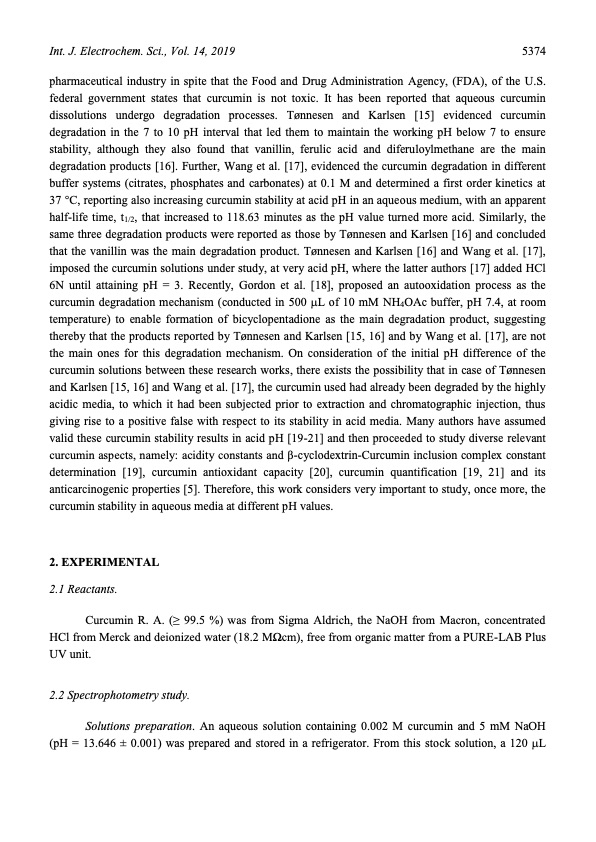
PDF Publication Title:
Text from PDF Page: 002
Int. J. Electrochem. Sci., Vol. 14, 2019 5374 pharmaceutical industry in spite that the Food and Drug Administration Agency, (FDA), of the U.S. federal government states that curcumin is not toxic. It has been reported that aqueous curcumin dissolutions undergo degradation processes. Tønnesen and Karlsen [15] evidenced curcumin degradation in the 7 to 10 pH interval that led them to maintain the working pH below 7 to ensure stability, although they also found that vanillin, ferulic acid and diferuloylmethane are the main degradation products [16]. Further, Wang et al. [17], evidenced the curcumin degradation in different buffer systems (citrates, phosphates and carbonates) at 0.1 M and determined a first order kinetics at 37 °C, reporting also increasing curcumin stability at acid pH in an aqueous medium, with an apparent half-life time, t1/2, that increased to 118.63 minutes as the pH value turned more acid. Similarly, the same three degradation products were reported as those by Tønnesen and Karlsen [16] and concluded that the vanillin was the main degradation product. Tønnesen and Karlsen [16] and Wang et al. [17], imposed the curcumin solutions under study, at very acid pH, where the latter authors [17] added HCl 6N until attaining pH = 3. Recently, Gordon et al. [18], proposed an autooxidation process as the curcumin degradation mechanism (conducted in 500 L of 10 mM NH4OAc buffer, pH 7.4, at room temperature) to enable formation of bicyclopentadione as the main degradation product, suggesting thereby that the products reported by Tønnesen and Karlsen [15, 16] and by Wang et al. [17], are not the main ones for this degradation mechanism. On consideration of the initial pH difference of the curcumin solutions between these research works, there exists the possibility that in case of Tønnesen and Karlsen [15, 16] and Wang et al. [17], the curcumin used had already been degraded by the highly acidic media, to which it had been subjected prior to extraction and chromatographic injection, thus giving rise to a positive false with respect to its stability in acid media. Many authors have assumed valid these curcumin stability results in acid pH [19-21] and then proceeded to study diverse relevant curcumin aspects, namely: acidity constants and β-cyclodextrin-Curcumin inclusion complex constant determination [19], curcumin antioxidant capacity [20], curcumin quantification [19, 21] and its anticarcinogenic properties [5]. Therefore, this work considers very important to study, once more, the curcumin stability in aqueous media at different pH values. 2. EXPERIMENTAL 2.1 Reactants. Curcumin R. A. (≥ 99.5 %) was from Sigma Aldrich, the NaOH from Macron, concentrated HCl from Merck and deionized water (18.2 MΩcm), free from organic matter from a PURE-LAB Plus UV unit. 2.2 Spectrophotometry study. Solutions preparation. An aqueous solution containing 0.002 M curcumin and 5 mM NaOH (pH = 13.646 ± 0.001) was prepared and stored in a refrigerator. From this stock solution, a 120 LPDF Image | Curcumin in Aqueous Media at Different pH

PDF Search Title:
Curcumin in Aqueous Media at Different pHOriginal File Name Searched:
140605373.pdfDIY PDF Search: Google It | Yahoo | Bing
CO2 Organic Rankine Cycle Experimenter Platform The supercritical CO2 phase change system is both a heat pump and organic rankine cycle which can be used for those purposes and as a supercritical extractor for advanced subcritical and supercritical extraction technology. Uses include producing nanoparticles, precious metal CO2 extraction, lithium battery recycling, and other applications... More Info
Heat Pumps CO2 ORC Heat Pump System Platform More Info
| CONTACT TEL: 608-238-6001 Email: greg@infinityturbine.com | RSS | AMP |